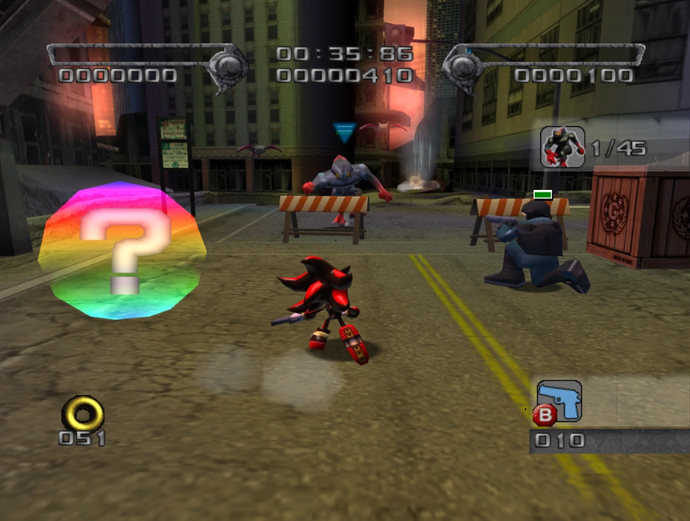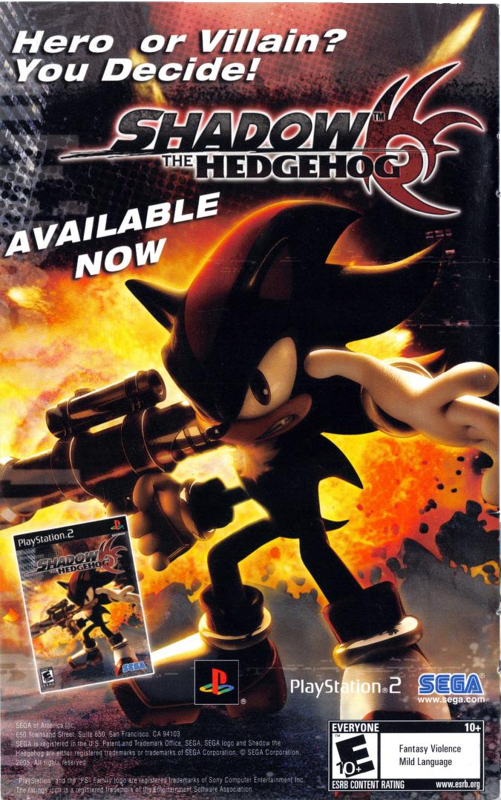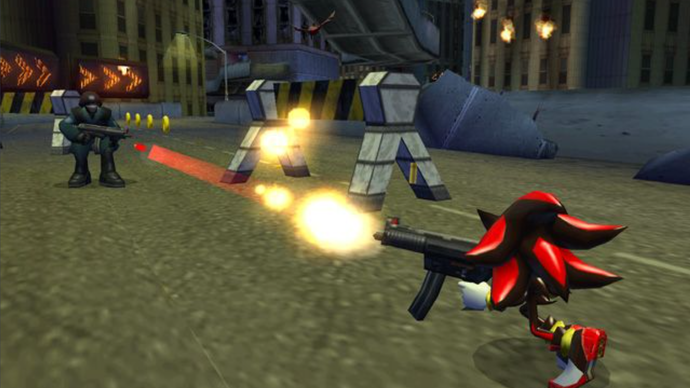The day was 8th March 2005. The event: the inaugural Walk of Game celebration, in which gaming icons Mario, Link, Sonic and Master Chief were recognised for their contributions to the industry. Sonic even got a nice trailer showcasing his most glorious exploits since his inception in 1991.
As the video wrapped up, no one could have predicted what happened next. Shots of classic 2D Sonic were suddenly riddled with bullet holes. The screen, full of happy memories, was shattered, revealing a morose Shadow the Hedgehog – and this hog was packing heat. The footage that followed featured Shadow running, jumping and bouncing around environments similar to previous 3D Sonic games, with one not-so-subtle new feature: guns. Laser guns, machine guns, pistols, you name it. And Shadow wasn’t afraid to use them to blow the game’s alien enemies away. No, this wasn’t an April Fool’s joke, a hallucination or a mod by an angry prepubescent wishing their colourful cartoon mascot would grow up and start handling his problems like an adult. This was a legitimate Sonic Team-developed game in the Sonic the Hedgehog franchise featuring firearms, and it was coming that holiday season – whether we liked it or not.
I vividly remember the myriad questions that ran through my teenage mind on first seeing the trailer. Why did this game exist? Who signed off on this utterly pants idea? A solo Shadow game wasn’t far-fetched by any means – his surge in popularity after his debut in Sonic Adventure 2 was undeniable. But why take the Sonic series down the same dark, edgy road other franchises like Jak and Daxter and Prince of Persia had already trodden?
To answer those questions meant looking at the paradigm shift the video game industry was undergoing at the time. Dark, brooding anti-heroes were all the rage in the early-to-mid 2000s. Colourful mascot platformers had been unceremoniously shoved off their pedestal as the dominant gaming genre by first- and third-person shooters – perhaps most notably by the Halo series. US gamers in particular were flocking to the genre in droves, and it was to that group that scenario writer and director Takashi Iizuka sought to appeal

The story opens with an amnesiac Shadow wandering the city outskirts, struggling to remember the secrets to his past that have eluded him since first being awakened in Sonic Adventure 2. As luck would have it, the one person who can answer his questions appears right in front of him at that exact moment: the evil alien Black Doom, who claims to have ties to Shadow and will divulge what he knows if Shadow gathers the Chaos Emeralds for him. The thing is, Black Doom is also trying to conquer the planet with his alien forces known as the Black Arms, leaving Shadow with a huge moral quandary on his hands.
That’s where arguably the most interesting aspect of the game comes into play: Shadow’s morality system. Does he fight for the planet and fend off the alien invaders, side with the Black Arms in their conquest, or barrel ahead without paying heed to the conflict at all? Each level allows players to decide for themselves. In the opening stage Westopolis, for instance, you can gun down the soldiers repelling the alien invasion, save the city by taking out the aliens, or remain neutral and simply race to the end of the level. Your chosen path dictates which level you tackle next. It’s up to the player to determine whether they want to go pure hero, pure villain, stay neutral, or bounce around like a morally confused pinball depending on their mood.

Eventually, you’ll reach one of the game’s ten initial endings, ranging from Shadow decimating the planet’s military, beating up Black Doom, deciding to take over the world himself, or a variety of paths in between. All in all, there are a whopping 326 different pathways you can take to clear the game. While only the most hardcore fans are likely to try, you have to admire Sonic Team’s dedication.
However, the story doesn’t stop there. While you’re free to play through the game once and call it quits, it’s only by unlocking all ten initial endings that the final story becomes available. There is a canon ending, and – spoiler alert – at the end of the day, Shadow’s a brave-hearted hero. Well, anti-brave-hearted hero, anyway. You won’t see Sonic shooting an alien in the face with a machine gun anytime soon.
Speaking of, let’s delve deeper into its weapons-based combat. At its most basic, Shadow the Hedgehog plays like the 3D Sonic titles that preceded it; Shadow can run, jump, home in on enemies, and even engage in fisticuffs when his hands are free. Unlike previous Sonic games, however, upon defeating an enemy, Shadow can commandeer their weapons for his own use, including a wide variety of guns, swords, hammers, spears and grenade launchers. Players who recoil at the thought of using weapons in a Sonic game can finish the adventure without ever touching them, though they are significantly more effective at clearing out enemies than your standard homing attack – undoubtedly an intentional move by the developers to encourage their use. It’s easy to argue that the ultimate lifeform using a weapon is as redundant as Sonic driving a car – to say nothing of the silliness of the concept – but from a gameplay perspective, the implementation is competent enough.

The game’s edginess goes beyond firearms, though. Keeping with the more mature tone, the developers allowed the characters to drop their filters and belt out some salty language. You’re not going to hear the characters you’ve known and loved for years dropping F-bombs (though the game did initially feature some stronger language, according to Shadow’s voice actor Jason Griffith), but there is mild profanity throughout, mostly by Shadow himself. Of course, it’s debatable whether it makes the game edgier or simply more meme-able. The alien enemies also bleed when hit, though their blood was changed from red to green to keep the game’s rating down. It’s relatively tame compared to many games in this day and age, but it was still certainly jarring to see in a Sonic the Hedgehog game nonetheless.
So, then comes the million-dollar question. Taking everything into consideration, is Shadow the Hedgehog a good game?
As someone who grew up with Sonic from the very beginning and was completely taken aback when Shadow’s solo title was announced, it’s… fine. Like, surprisingly fine. Was it a dumb idea? Absolutely. Was it a blatant attempt at cashing in on the dark and edgy game craze? Almost certainly. Was it executed decently despite all this? I personally lean toward yes, but ‘decent’ is about the highest praise I can give it.
Plenty of Sonic games are still widely discussed by the community and greater internet decades after release, for better or worse. Sonic 06. Unleashed. Colours. Beyond the occasional meme, Shadow isn’t one of them. Even Sonic Team itself tend to gloss over the game; the only legal way to play it is by purchasing a used copy for sixth generation consoles, and official references that aren’t outright mocking it are rare to non-existent.
That’s part of what makes the recently-released Sonic X Shadow Generations, and the Sonic the Hedgehog 3 film, so significant. For the first time since Shadow the Hedgehog, Sonic Team is taking a deep dive back into the character’s rich but troubled history as part of its broader Year of Shadow celebration. We even get to witness the unexpected return of Black Doom, undoubtedly a past version of the character brought about via the game’s time travel shenanigans.
Just as Shadow must once again confront his ugly past, so too is Sonic Team bravely acknowledging one of its biggest misfires in the hopes it can find something worth salvaging. While I doubt the new Shadow-centric story campaign is going to retroactively sway public opinion in favor of his original solo outing, it is nevertheless a potent reminder that, despite its laughable concept and numerous shortcomings, Shadow the Hedgehog did have some cool ideas.
